Adam Yamey's Blog: YAMEY, page 238
October 27, 2012
NEXT YEAR IN TIRANA
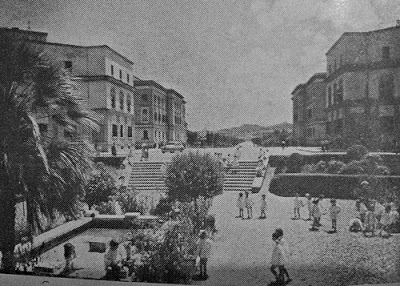
The words 'next year in Jerusalem' are recited at the end of every Passover celebration.
But, what would have happened if Albania had become the Jewish Homeland instead of Palestine?
A far-fetched question, you might exclaim, but read on...
Of all the countries in mainland Europe occupied by the Axis Powers during the Second World War, Albania was unique in at least one respect. The number of Jews in that country was greater in 1945 than in 1939 despite being occupied by the 'Nazis'.
This is reasonably well-known. However, what is much less well-known (to me, at least) is that once Albania was under consideration as a new homeland for the Jewish People.
Leo Elton (1883-1947), visited Albania in 1935. His niece, Dorothea Shefer-Vanson, wrote as follows:
"An item in the newspaper ...
...mentioned a document that had been sent to the president of the Hebrew University in 1945 concerning the possibility of settling some of the Jewish refugees then unable to gain access to Mandate-controlled Palestine in Albania. The idea itself was not so alien to me (it is mentioned in Martin Gilbert’s book Churchill and the Jews), but what made me catch my breath was the author of the document. This was Leo Elton, described as ‘a Zionist British journalist’ and known to me as a cousin of my father....
...From the handwritten letter accompanying the report we learned that Leo Elton had indeed visited Albania in 1935. He did so at his own initiative, prompted by newspaper reports of Albania’s willingness to accept Jewish immigration and the restrictions imposed upon entry into the Land of Israel by the British Mandatory authorities. As Martin pointed out, Uncle Leo, though no journalist, was a businessman and hence travelled extensively.The report is entitled ‘Impressions of a Visit to Albania with Some Observations upon the Opportunities Open to Jewish Settlers in that Country’. Written in impeccable if somewhat flowery English, the report describes in considerable detail the physical, social and economic conditions of Albania, noting ‘it touches the heart how Albania too withered for so long under the blighting hand of the Turk.’ The comparison with the situation in Mandatory Palestine is very clear, and Uncle Leo points out: ‘Although I judge Albania to possess many great natural advantages over Palestine, it has travelled but a very few steps compared with the latter on the road back to vigour and prosperity....
...The soil of Albania is described as fertile and its population sparse, with only one million inhabitants. Leo Elton found that though the population was Muslim, it was not warlike or extreme in character. As we know today, only one Albanian-Jewish family was deported and killed by the Nazis, despite Mussolini’s occupation of the country. All Albania’s Jews were taken in and protected by their Muslim neighbours... "
The whole article may be read by clicking HERE
More detail about Elton's visit were published recently in Haaretz, a Jewish newspaper:
"...So he traveled to the tiny country of a million inhabitants, which was completely cut off from industrialized Europe. A government minister told him that "in Albaniareligious intolerance is quite unknown .... The Albanian Muslims of today are no fanatics."
The minister also emphasized that, in contrast to the rest of Europe, Albania had no history of anti-Semitism. "There is no reason whatsoever to expect that Jewish settlers would not live in complete harmony with the population's diverse elements," Elton wrote...
...The oranges and lemons, Elton enthused, were the best in the world, and Jews' success in raising oranges in pre-state Israelcould be replicated in Albania. Other suggestions included growing tobacco and raising silkworms, and building up the textile and olive-oil industries. The less positive side, according to Elton, was that the capital Tirana had no theaters or concert halls...
...As a first stage Elton recommended establishing a Jewish national entity in Albania like the one in Mandatory Palestine, with the cooperation of two Zionist movements. Later Albania might even be turned into a Jewish national home..."
The full text of this article may be read by clicking HERE
You can read more about ALBANIA by clicking HERE
Published on October 27, 2012 07:34
ALBANIAN LIBRARY
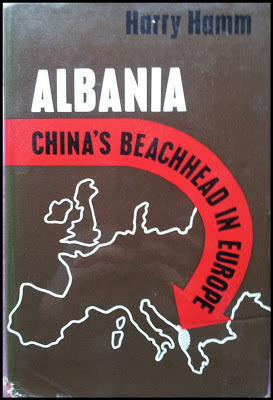
This is a brief annotated bibliography containing some of the books on Albania,which I have enhoyed reading. It is by no means comprehensive. I have arranged them in order of date of publication.
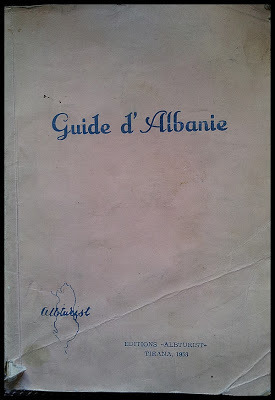
Durham, M.E.: “High Albania”, publ. Edward Arnold (London) 1909. Margaret Durham was an anthropologist who fell in love with the Balkans. This describes in great detail the history and anthropology of the tribes living in the remote mountains of northern Albania. There are modern editions of this beautifully written and illustrated classic available.
Peacock, W.: “Albania: The FoundlingState of Europe”, publ. Chapman & Hall (London), 1914. This is a fascinating, detailed account of life in and around Shkodër during the first years of Albanian independence. The author was attached to the British Consulate in Shkodër. His chapter on the future of Albania makes for interesting reading in the light of what actually happened.
Gordon, J & Gordon, C.: “Two vagabonds in Albania”, publ. John Lane The Bodley Head (London), 1927. Jan and Cora Gordon wrote a large number of “Two Vagabonds in…” travelogues. This one, which describes their trip to Albania, is beautifully illustrated with the authors’ line drawings and chalk sketches. The text is humorous and informative.
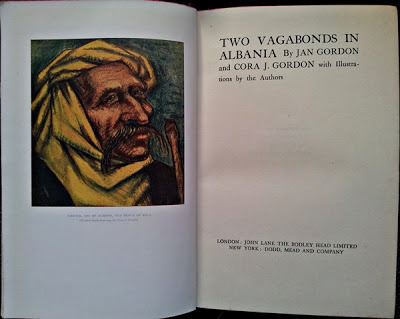
Bridge, A.: “Singing Waters”, publ. Macmillan (New York), 1946. Not quite as good as Bridge’s “Illyrian Spring”, her superb novel set in the Balkans, “Singing Waters” is set largely in Albania.
Muggeridge, M. (ed.): “Ciano’s Diary: 1939 -1943”, publ. William Heinemann (London), 1947. This is a translation of Count Ciano’s secret diary, which was smuggled out of Italyby Ciano’s wife at the end of WW2. According to Mosely, who wrote a biography of Ciano, this is a largely accurate account of the events described in the diary. The first chapter of the diary describes the vents leading up to the Italian invasion of Albania.
Buda, A., Cun, J., Rrok, Z., & Skënder, A.: “Guide d’Albanie”, publ. by Editions “Albturist” (Tirana), 1958. Difficult to obtain, this guide produced whilst the Albanians were still allies of the Soviet Union is remarkably detailed. The historical section ends with an affirmation of the country’s alliance with the Soviet Union, ‘… le grand sauveur et défenseur de notre people.”
Hamm, H.: “Albania - China’s beachhead in Europe”, publ. Weidenfeld & Nicolson (London), 1963. Harry Hamm was a German journalist who was allowed to visit Albania in 1962. He was the first western journalist to visit the country since 1957. He arrived just after the Albanians had divorced themselves from the Soviet Union. He describes this break up between former allies in great detail. He also foretells the alliance of Albaniaand the People’s Republic of China, which began soon after his visit. Hard to find, this is a fascinating book.
Logoreci, A.: “The Albanians”, publ. Westview Press (Colorado), 1977. Published just after the death of Mao Tse Tung, this scholarly but readable book gives many interesting insights about the political, social, and economic conditions prevailing in Hoxha’s Albania. He predicts the rift that developed between Chinaand Albanianot long after Mao’s death. The book ends with a comprehensive reading list over five pages in length.
Kadare, I.: “Broken April”. First published in 1978, numerous editions are available. This haunting tale, which revolves around the Law of Lek, the codification of feuding in traditional Albania, is a brief but brilliant story about the last days of a young man expecting to be killed in an inter-familial vendetta. As in his other works, Ismail Kadare captures a great deal with a few words.
Ward, P.: “Albania”, publ. Oleander Press (Cambridge), 1983. The author describes his trip to Albaniaand uses it as the framework for his informative illustrated guidebook. It is the most interesting guidebook to the country that I have come across.
Halliday, J.: “The Artful Albanian”, publ. Chatto & Windus, 1986. This book contains a number of extracts from the voluminous writings of Enver Hoxha and interesting commentaries about them. I lent my copy to one of the people with whom I travelled to Albania, and she never returned it. If she is reading this now, I ask her to return it immediately.
Robyns, G.: “Geraldine of the Albanians: The Authorised Biography”, publ. Frederick Muller Ltd, 1987. This true-life Mills and Boon tale, a biography of King Zog’s Hungarian wife, was written by Barbara Cartland’s biographer. It includes a description of Geraldine whimpering into her pillow on being deflowered.
Jones, L.: “Biografi”, publ. André Deutsch, 1993. This curious tale about the fate of one of Enver Hoxha’s doubles in post-communist Albaniacontains good descriptions of conditions in the country soon after the end of communist rule.
Pettifer, J.: “Blue Guide: Albania”, publ. A&C Black (London), 1994. Published soon after Albania shed its communist regime, this detailed guidebook does its best in his section on ‘Personal Security’ to portray Albaniaas a lawless place, to which only the foolhardy visitor should stray. This book provides an encyclopaedic account of Albania and her people.
Mosely, R.: “Mussolini’s Shadow”, publ. Yale University Press (New Haven), 1999.This detailed biography of Count Ciano, Mussolini’s foreign minister and son-in-law contains a chapter on the Italian involvement in in Albania during WW2.
Kadare, I.: “The Successor”, published in 2003. This chilling tale, which explores the mysterious death of the successor to a political leader, is most probably based on the sudden death of Enver Hoxha’s right hand man and probable successor Mehmet Shehu.
Tomes, J.: “King Zog: Self-made monarch of Albania”, publ. Sutton (Stroud, Gloucestershire), 2003. This well-written, interestingly detailed account of Zog’s life in Albania, and then later in exile, includes a chapter about the Western Allies attempts to wrest Albaniafrom the Communists in the 1950s.
Kadare, I.: “The Accident: a novel”, first published in 2009. This recent novel by world famous author Ismail Kadare concerns the investigation of a mysterious traffic accident near to Vienna’s airport. This story does not make for easy reading. It is deliberately confusing. I suspect that it gives the reader a good insight into the tortuous thought processes that were needed to survive in the oppressive atmosphere that was inspired by Albania's long serving dictator Enver Hoxha.
HAVE you read "ROGUE OF ROUXVILLE" ?
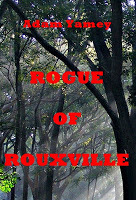
Dicing with debt, Jakob Klein struggles to support his growing family. He'll stop at nothing to achieve this. His dubious business ethics inevitably lead him into trouble with the law. He is imprisoned. His family have to flee from the small town in the Orange Free State, where they have lived.
What wll become of them, and of Jakob? Will they ever be reunited?
Read all about it in Adam Yamey's historical novel "ROGUE OF ROUXVILLE", available on AMAZON (Click HERE FOR KINDLE) and also on www.lulu.com (Click HERE FOR PAPERBACK ) .
For more details, click HERE
Published on October 27, 2012 05:09
October 13, 2012
KONG TO COCTEAU
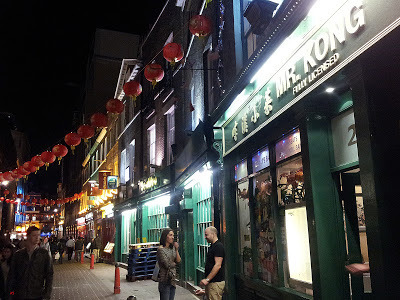
Last night we dined at 'Mr Kong', one of the numerous chinese restaurants in Soho's Lisle Street. It is located near to a gabled building, which was until recently. the St Johns Hospital for Diseases of the Skin. Now it houses the 'Slug and lettuce' pub.
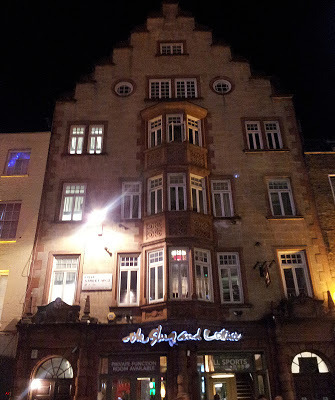
We ate a good meal. It consisted of: crispy seaweed, razor clam, hot and sour soup, roast pork with garlic shoots (these look like thin green beans), fried mussels in black bean sauce, and deep fried salted aubergine and tofu. The latter, a vegetarian dish, was as delicately fried as the best Japanese tempura. It is one of the dishes on Mr Kong's special vegetarian menu. I could not decide which I enjoyed more - the mussels or the 'veg' dish. In any case, this restaurant has been one of the best in London's China Town since it opened in 1984.
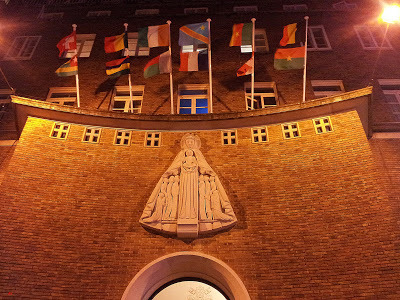
A short lane leads from Lisle Street to Leicester Square. Almost next door to the Prince Charles cinema and surmounted by the flags of the francophone nations is the main entrance to Notre Dame de France, a French Roman Catholic church. After climbing a few stairs, the circular church opens up in front of you.
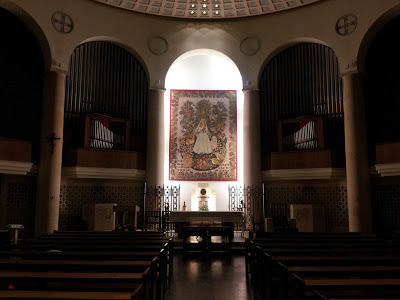
On the left side of the high altar, at ninety degrees to it, there is a side chapel that contains a wonderful surprise.
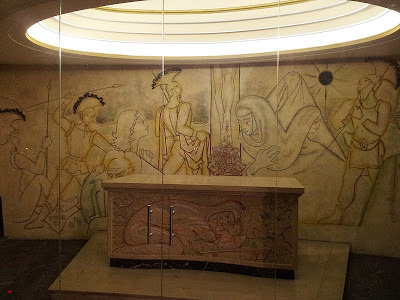
The walls surrounding the altar, whose front is decorated with a mosaic by Boris Anrep (1883-1969), are covered with a mural depicting the Crucifixion. This was drawn on the wall by Jean Cocteau in 1960. It is an unusual crucifixion because the only parts of Christ that have been drawn are his nailed feet and the lower part of his legs.
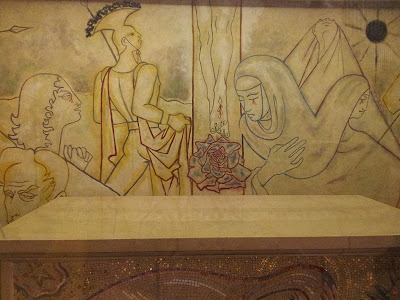
Now, why not read "ROGUE OF ROUXVILLE" ?
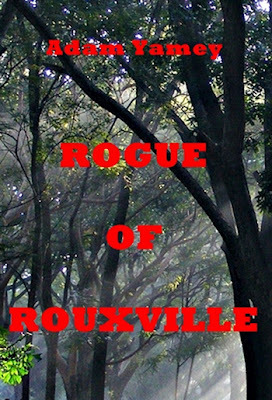
Dicing with debt, Jakob Klein struggles to support his growing family. He'll stop at nothing to achieve this. His dubious business ethics inevitably lead him into trouble with the law. He is imprisoned. His family have to flee from the small town in the Orange Free State, where they have lived.
What wll become of them, and of Jakob? Will they ever be reunited?
Read all about it in Adam Yamey's historical novel "ROGUE OF ROUXVILLE", available on AMAZON (Click HERE FOR KINDLE) and also on www.lulu.com (Click HERE FOR PAPERBACK ) .
For more details, click HERE
Published on October 13, 2012 07:00
October 6, 2012
ALBANIA: 1984 - SLOGANS
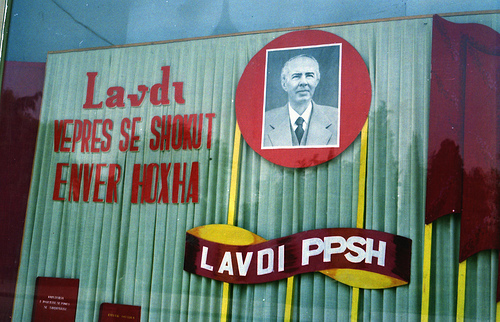
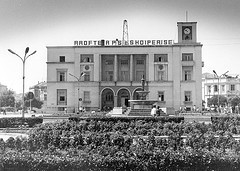
It was a long drive from Korçë back to Tirana. We passed countless domed concrete bunkers and a stream of political slogans. Some of these, which were as widely distributed throughout the country as were the bunkers, were on hoardings by the roadside. Others were spelled out in enormous letters on hillsides and mountain tops and could be seen for miles around. The letters forming these gigantic propaganda messages were made up of innumerable white pebbles painstakingly gathered together by children and other ‘volunteers’. This is well illustrated in “Slogans”, a film by an Albanian director made in 2001.
T he film depicts a school in a small Albanian village during the late 1970s. The director has had news that an important party member is planning to visit the area. The teachers take their young pupils out onto a mountainside and day after day they collect stones and frantically prepare a giant political slogan. Meanwhile, other preparations are being made to welcome the dignitary. The great day finally arrives, and the villagers line up along the village street, waiting excitedly. The car carrying the celebrity roars right through the village at high speed without stopping. The party member being transported does not even look up from the papers that he was perusing as he was driven past the people so eagerly awaiting his visit.
The roadside propaganda was so successful that a number of the messages remained firmly etched in my brain. There were many slogans plastered all over the country, but little variety in the messages that they conveyed. “Work, Disciple, Vigilance” written in Albanian, was a common roadside exhortation. Many a mountainside was adorned with “Parti Enver” (‘Party of Enver’) or “Laudi PPSH”, which those who have learnt Latin will recognise as meaning ‘Praise the PPSH’ (PPSH being an abbreviation for ‘Partia e Punës e Shqipërisë’ - the Albanian Workers' Party. And, the words “Rroftë shoku Enver!” that translate as ‘Long live Comrade Enver’ praised the country’s only party’s leader.
I n 2001, long after my trip to Albania, I began working in a dental practice in west London. Many of my patients were and still are refugees from the places in the world, which are stricken by military and political conflicts. Algerians, Iraqis, Afghans, Kurds, Palestinians, Eritreans, and many other others who have fled their far-off disturbed homes sit in my surgery and reveal the ravages that life has inflicted on their teeth. During the terrible conflicts in the former Yugoslavia, many of my patients hailed from Kosovo, and usually spoke poor English in addition to their native Albanian. Many was the smile I elicited from them when I quoted the old party slogans, and wished them ‘Mir u pafshim’ instead of ‘Goodbye’.
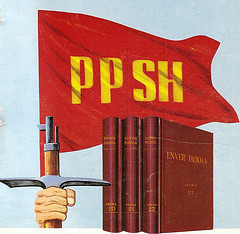
Published on October 06, 2012 03:03
September 30, 2012
OUT OF AFRICA
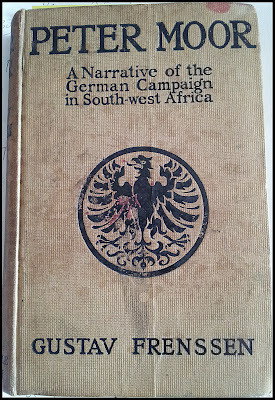
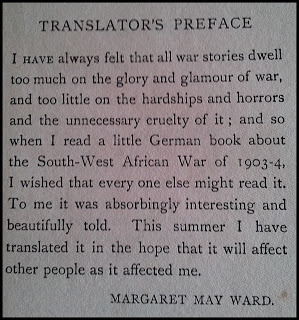
Some months ago, I mentioned to my father that I was reading “The Kaiser’s Holocaust”, a book by Olusaga and Erichsen about the 1903-1908 German massacres of the Herero and other ‘native’ people in German Southwest Africa (‘SWA’, now ‘Namibia’). My father remembered that whilst he was a schoolboy in a small town in South Africaduring the early 1930s, he had read a book in German about a soldier who took part in the campaign. Its vivid descriptions had made a lasting impression on him. He remembered that its title contained the name ‘Peter Moor’. I was curious to read it if it were available in translation.
I found bought a copy of “Peter Moor's journey to Southwest Africa; a narrative of the German campaign” (‘Peter Moor’ for short) from a second-hand bookseller. The story written by Gustav Frenssen (1863-1945) was first published in German in 1906, and then translated into English by Margaret May Ward in 1908. My copy is a 1914 reprint. The book is rare, and now rarely read. However, the translation is available on-line (see: http://archive.org/details/petermoorsjourn00frengoog).
In 1903, the 17 year old Peter Moor, the hero of the book, decides to enlist in the German naval reserves, most probably in order to get to see a little more of the world. Soon after he has joined up, a friend tells him: “In southwest Africathe blacks, like cowards, have treacherously murdered all the farmers and their wives and children.”Peter asks: “Are those murdered people Germans?” He learns that they are, and immediately volunteers to join the troops being sent by ship to SWA. He sets sail.
During the long sea voyage, in which he spends a day or two in Madeira, he watches the black men on board the ship, and concludes, “It seemed to me like this: that the people of Madeira, although strangers to us, are like cousins whom we seldom see; but that these blacks are quite, quite different from us, so that there could be at heart no possible understanding or relationship between us. There must always be misunderstandings instead.”Were these really the thoughts of a teenager keen to discover the wide world or is this an example of the seeds of racism, which Frenssen was attempting to sow in the minds of his, mainly young, readers?
Moor reaches the port of Swakopmund in SWA, and discovers that he has not landed in a bed of roses. Instead, he has entered a hostile environment, one which will harshly dominate his experiences whilst he is in Africa. Some weeks later, he sees: “… a great covered wagon left deserted on the road. A farmer or trader had wanted to escape, had packed his most valuable possessions in the wagon, harnessed his oxen to it, and driven the rest of his flocks before it. He had come as far as this. His bones lay eaten by beasts,…, and round the wagon were strewn the only things which the enemy couldn’t use…”After giving the (German) farmer’s bones a Christian burial, they moved on and after a short while, discovered “… many deserted huts of the enemy.” Although he and his comrades were so tired, they, “…took time to set fire to these…”
Peter Moor is naturally distressed by the fate of his fellow countrymen, their deaths caused by the rebellious Africans, but he is not unaware of the reasons behind it. For, one day, an older German man, who has lived in SWA for several years explains the behaviour of the Africans to him, and therefore to the reader as well, “Children, how should it be otherwise? They were ranchmen and proprietors, and we were to make them landless working men; and they rose up in revolt. They acted just the same way that North Germany did in 1813. This is their struggle for independence.”This is a remarkable admission from a writer who, according to an article in ‘Wikipedia’, abandoned Christianity and became a blatant racist.
Much of the book is concerned with the discomforts of life in the harsh environment that Moor in which he finds himself. He is plagued, by thirst, hunger, fatigue, disease, and the occasional minor wound. However, he is luckier than many of his fellow soldiers in that he lives to tell the tale without losing any limbs, or worse. For days and weeks they ride or walk through the wilderness, trying to track down their often elusive enemy. The author portrays the slowness of the campaign and the discomforts of this kind of life excellently. His book deserves to be read in order to dispel the glamour of warfare, but on the other hand its present obscurity is not a bad thing given the racist sentiments that are often expressed in it.
A long time passes before the Germans catch up with the African people whom they are trying either to kill or to chase out of their colony. One night they get close enough for Peter to spy on an encampment at the base of some mountains. He was struck by a thought: “There lies a people, with all its children and all its possessions, hard pressed on all sides by the horrible, deadly lead, and condemned to death.”This thought, says Peter, “…sent cold shudders down my back.” And, rightly so given what we now know of the awful fate of the African people in German SWA.
After the reader has been subjected to many pages describing Peter’s wanderings through a most hostile environment, he becomes aware that many of his African enemies had perished, and the rest were fleeing towards the inhospitable terrain at the eastern edge of the colony, where, “…thousands of them had perished” already. Victory was in sight, yet, “The general decided to follow them thither, to attack them and force them to go northwards into thirst and death, so that the colony would be left in peace and quiet for all times.” Thus, the Germans hoped to establish Lebensraum in Africa.
A few days later, Peter and his companions stumbled upon five African men with their families. After shooting the men, he describes how the women and children were, “…hunted into the bush.” As the book nears its ending, the writer’s tone becomes increasingly harsh. He describes a religious service ordered by one of the generals, whom Peter meets in the bush. After singing a hymn, the chaplain says: “A people savage by nature had rebelled against the authorities that God had set over them. Then the authorities had given the sword, which we were to use on the morrow, into our hands. Might every man of us use it honourably, like a good soldier…” Peter and his companions did as commanded. Two days later, this same chaplain preached: “These blacks have deserved death before God and man, not because they have murdered two hundred farmers and revolted against us, but because they have built no houses and dug no wells… God has let us conquer because we are the nobler and more advanced people … to the nobler and more vigorous belongs the world. That is the justice of God.” ‘Peter Moor’ was written long before Mein Kampf. So, maybe we should not have been too surprised when Hitler and his generals led his Herrenvolk into war with the rest of the world.
However, the Africans, desperate as their situation had become, did not give up without a fight. In their wake, they left “… great clouds of smoke and flame” behind them as they were “… burning the sparse, dry fodder” in the land through which the Germans would have to chase them.
Eventually nothing was to be seen of the Africans “…except below in the distance, where a monstrous cloud of dust was moving swiftly across the plain. Then it was clear that the proud nation had lost all courage and hope, and preferred to die in the desert rather than to fight any more with us.” Peter was under no illusion about their fate. They were moving “… toward certain death from thirst.”
In the last pages of the book, Peter makes this sinister remark after seeing the corpse of an African boy: “It is strange what a matter of indifference another man’s life is to us when he belongs to another race.” I imagine that it was thoughts such as this that made it easier for the murderers of the Jews and members of other ‘races’ a few decades after the Germans had massacred most of the Africans in their colony. Yet, here it is coolly expressed in a book amongst whose intended audience were impressionable young people.
Another incident which Peter describes is the capturing of a Negro who was carrying a gun. After his colleague had questioned this fellow, he says: “The missionary said to me, Beloved don’t forget the blacks are our brothers.’ Now I will give my brother his reward.”Having said those words, he told the captive to run away to freedom, but hardly had the unfortunate taken five leaps, he shot him dead. A few moments later, he told Peter:“Safe is safe. He can’t raise a gun against us any more, nor beget any more children to fight against us. The struggle for South Africawill still be a hard one, whether it is to belong to the Germans or the blacks.” As to the hard struggle, Frenssen certainly did not underestimate reality, but the message he conveyed to his readers was not one which was likely to reduce its intensity.
Frenssen’s hero, Peter Moor, was a creation of his imagination. His experiences described in the book were drawn from what he had learnt from veterans of the German’s African campaign. The authors of “The Kaiser’s Holocaust” point out that “Peter Moor” was “… a simplistic dramatised account of the Herero-Nama genocides…” and point out that it was “… the best-selling children’s book in Germany until 1945.” One can understand its popularity. It is well-written, at times gripping, and always heroic. However, even if we heed Lord Justice Denning’s advice that “We must not look at the 1947 incident with 1954 spectacles”, and not look at something written in 1906 with 2012 spectacles, we cannot forgive the author for encouraging malicious thoughts of racial superiority in the minds of his young readers. Contemporary writers such as the British John Buchan (1875-1940) and Dornford Yates( 1885-1960) were prone to planting prejudices against ‘foreigners’ in their books, but none of them were as virulently hateful as Frenssen appears to have been in his “Peter Moor”.
In conclusion, I can recommend “Peter Moor” to those who take an interest in obscenities in world literature such as “Mein Kampf” and “The Protocols of The Learned Elders of Zion.” This book should definitely be excluded from any reading lists for children, towards whom it was originally aimed.
And,
now for something completely different:
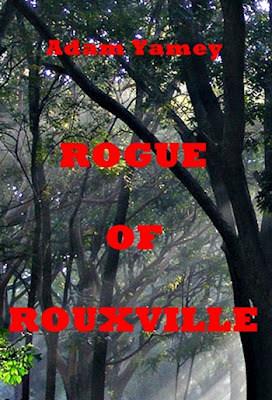
Read Adam Yamey's "ROGUE OF ROUXVILLE", a new adventure story set in southern Africa's Orange Free State during the 1870s.
Available: as a paperback by clicking: HERE, or download it on to your Kindle from AMAZON's websites -Amazon.com, click HEREAmazon.co.uk, click HERE
Published on September 30, 2012 04:08
September 29, 2012
KINDLE PROMOTION
OSTRICHES ???
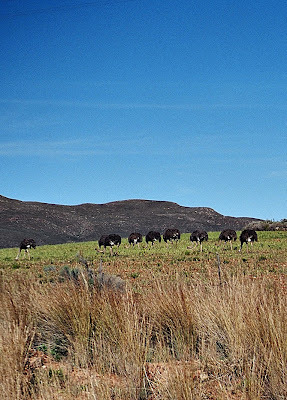
How did Jakob Klein, the hero of Adam Yamey's "Rogue of Rouxville" become involved with these flightless creatures?
And, why did he, a young immigrant from Bavaria, get locked up in a jail in a small town in the old Orange Free State?
Then again, what led to this altercation ?:
"Hey Constable, what’s your bleddy hurry? Look you’ve spilt my drink all over my waistcoat.”
“Shtand ashide for an offisher of the law,” Röttcher shouted, pushing his assailant away.
The man he had just upset was Dirk Van Der Walt, who lived up by the River Caledon and was visiting Rouxville for the weekend.
“Don’t molest me, Officer. I asked you why the hurry. And, what do you mean by your rudeness?”
“Make way for the law, I shed.”
“The law - that’s a good one, Constable Rotgut,” Van Der Walt said, bursting into laughter.
“I can arresht you for inshulting and asshaulting me.”
“Ag, drinking on duty, is it?”
“He’s the constable who’s friendly with that fellow Klein,” said someone standing nearby.
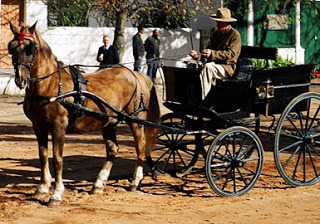
"ROGUE OF ROUXVILLE" is currently being offered at a special promotional price (US $ 1.49, UK £0.92) on Amazon's KINDLETo reach amazon.com click HERE !To reach amazon.co.uk click HERE !
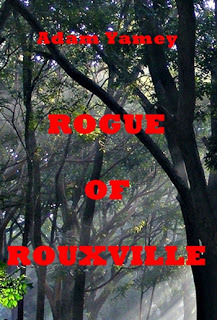


How did Jakob Klein, the hero of Adam Yamey's "Rogue of Rouxville" become involved with these flightless creatures?
And, why did he, a young immigrant from Bavaria, get locked up in a jail in a small town in the old Orange Free State?
Then again, what led to this altercation ?:
"Hey Constable, what’s your bleddy hurry? Look you’ve spilt my drink all over my waistcoat.”
“Shtand ashide for an offisher of the law,” Röttcher shouted, pushing his assailant away.
The man he had just upset was Dirk Van Der Walt, who lived up by the River Caledon and was visiting Rouxville for the weekend.
“Don’t molest me, Officer. I asked you why the hurry. And, what do you mean by your rudeness?”
“Make way for the law, I shed.”
“The law - that’s a good one, Constable Rotgut,” Van Der Walt said, bursting into laughter.
“I can arresht you for inshulting and asshaulting me.”
“Ag, drinking on duty, is it?”
“He’s the constable who’s friendly with that fellow Klein,” said someone standing nearby.

"ROGUE OF ROUXVILLE" is currently being offered at a special promotional price (US $ 1.49, UK £0.92) on Amazon's KINDLETo reach amazon.com click HERE !To reach amazon.co.uk click HERE !

Published on September 29, 2012 03:47
September 23, 2012
ON THE ROAD: ALBANIA 1984
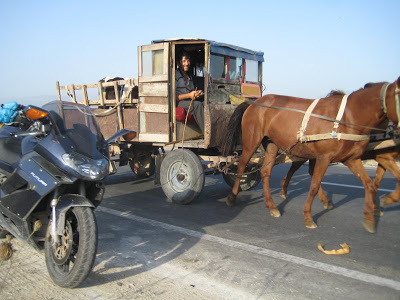 Image source: http://www.apriliaforum.com/forums/showthread.php?159832-By-Futura-to-Istanbul-And-beyond/
Image source: http://www.apriliaforum.com/forums/showthread.php?159832-By-Futura-to-Istanbul-And-beyond/Given that the highway, on which we were travelling from Lezhë was the main road between the capital, Tiranë, and one of the country’s few border crossings, there was remarkably little motorised traffic on it. There were plenty of pedestrians and cyclists, very few buses and trucks, and no saloon (or estate) cars. Every now and then we met or passed a type vehicle the likes of which I have never seen anywhere else during my travels. It was a horse-drawn lorry. Imagine a motorised truck with its engine compartment sliced off neatly below the driver’s windscreen. What remains is a flat-fronted vehicle. Two slots cut below the part of the windscreen in front of the driver’s seat allow the driver to hold the reigns of the horses that provide the truck’s motive power. We encountered many of these vehicles on the roads in the country and towns during our visit to Albania.
We reached Tiranë, where we were assigned rooms in the then almost new Tirana Hotel, which, located in the city’s centre, was one of the city’s tallest buildings, more than 12 stories high. The view from our bedroom was wonderful. We looked down on Skanderbeg Square, which, despite being in the heart of the country’s largest city, was almost devoid of motor traffic. In addition to the infrequent appearances of often overcrowded public buses, the occasional Peugeot saloon car and Volvo estate car (the hardy, brick-shaped 240 series) would zip around the square. These foreign-built cars, and the even rarer Mercedes Benz, were used for government business. None of them were privately owned. During one of our stays in the city, some of group claimed to have glimpsed Enver Hoxha passing by in a Mercedes, but if Lloyd Jones novel “Biografi” has any truth in it, they may have only seen an Enver Hoxha lookalike!
This is an excerpt from a preliminary draft of my new book provisionally called "In Enver's Albania"
********************************
ALSO READ:
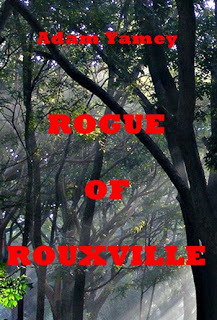
Available from www.lulu.com & Amazon - click HERE for purchasing details and other information
Published on September 23, 2012 03:52
September 21, 2012
'MONSOON' IN NORTHERN ALBANIA, MAY 1984
 From: http://www.trekearth.com/gallery/Europe/Albania/North/Shkoder/photo486166.htm
From: http://www.trekearth.com/gallery/Europe/Albania/North/Shkoder/photo486166.htmWe boarded our coach the next morning, and drove out of Shkodër to visit the multi-arched Turkish bridge at Mesi. Having admired that briefly, we returned to the centre of Shkodër, and followed another road that radiated from its centre until we reached a factory on its outskirts. After waiting for a heavy iron gate on rollers to be opened, we drove inside the compound containing what we were told was a copper wire factory. I was looking forward to visiting this establishment. However, before we had all disembarked, the heavens opened, and soon there were several inches of water on the poorly drained ground. We were told to get back into the bus and that our factory visit was to be aborted. It took a while to leave the compound because the sliding gate had somehow become jammed in its closed position by the rain waters.
The centre of Shkodër, through which we had to return, was flooded. People were splashing through the inundation, some with umbrellas, many without. I was not to see such a scene again for more than 10 years, when I began visiting India, sometimes during the Monsoon season.
Some years after my return from Albania, I purchased a copy of “Albania: the Foundling State of Europe” by Wadham Peacock, who was private secretary to the British Consul General in Shkodër. It was published in 1914 - one year after Albania became an independent nation. Peacock recorded that in his day Shkodër was subject to flash floods frequently. So, what we experienced in 1984 was nothing new.
________________________________________
Don't miss:

Read ROGUE OF ROUXVILLE in paperback ( click here )
OR
On your KINDLE ( Click here )
Published on September 21, 2012 13:25
September 16, 2012
DISCOVER THE ROGUE ON YOUR KINDLE
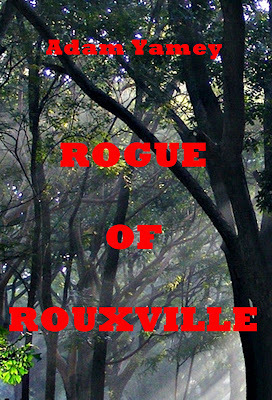
The ROGUE OF ROUXVILLE is now available as an electronic 'book' on Amazon's Kindle.
US (and most other) readers, click HERE !
In the UK, click HERE !
En France, clicquez ICI !
In Deutschland, LOS!
It is should ALSO be available on the Indian, Italan, and Spanish, Kindle Stores.
“I have certainly known more men destroyed by the desire to have a wife and child and keep them in comfort than I have seen destroyed by drink...” (William Butler Yeats, Diary, 1909)
Southern Africa during the 1870s.
Jakob Klein, a liberal-minded Jew from Bavaria, has been living in the small town of Rouxville in the Orange Free State for well over a decade.
He will try anything to support his wife and family. His questionable business ethics often cause him to sail close to the wind. Now, he has sailed far too close, and his life has capsized. His dubious dealings have lost him his home and livelihood. His young family have had to leave him to seek refuge with relatives in the Cape Colony.
Now, he is in jail, awaiting transfer to Bloemfontein, where the serious case against him is to be heard by the highest court in the land. With only his guards for company, he has plenty of time to wonder what sort of future fate holds for him and whether he will ever see his family again.
Read Jakob's story, a tale of debt and deception, in Rogue of Rouxville, Adam Yamey’s second historical novel. It is an adventure set mostly in the wilds of what was later to become the Union of South Africa.
More information on:
http://www.adamyamey.com
Published on September 16, 2012 04:36
September 9, 2012
A NEW ADVENTURE STORYIt is 1877. Jakob Klein, a libe...
A NEW ADVENTURE STORY
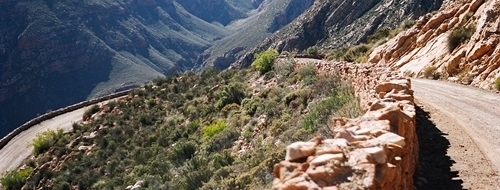
It is 1877.
Jakob Klein, a liberal-minded Jewish pioneer from Bavaria, has been living in the small town of Rouxville in the Orange Free State in southern Africa for well over a decade.
He will try anything to support his wife and young family. His questionable business ethics often cause him to sail close to the wind. This time, he has sailed far too close, and his life has capsized. His dubious dealings have lost him his home and livelihood. His young family have had to leave him to seek refuge with relatives in the Cape Colony.
Now, he is in jail, awaiting transfer to Bloemfontein where the serious case against him is to be heard by the highest court in the land. With only his guards for company, he has plenty of time to wonder what sort of future fate holds for him and whether he will ever see his family again.
Read Jakob's story in ROGUE OF ROUXVILLE. It is an exciting tale of debt and deception based loosely on the life of a real person, and set mostly in the wilds of what was later to become the Union of South Africa.
NOW AVAILABLE IN PAPERBACK:
Click
HERE !
to purchase a copy
Published on September 09, 2012 01:21



